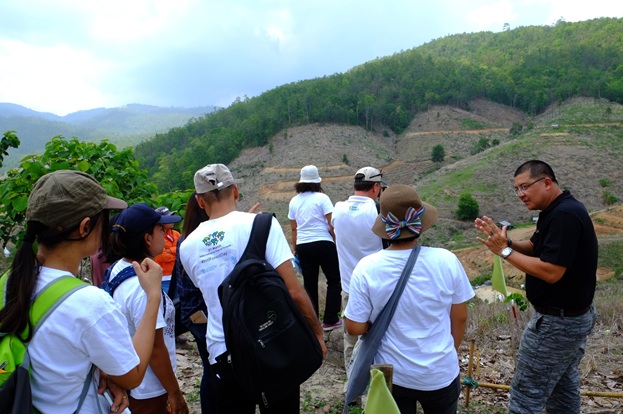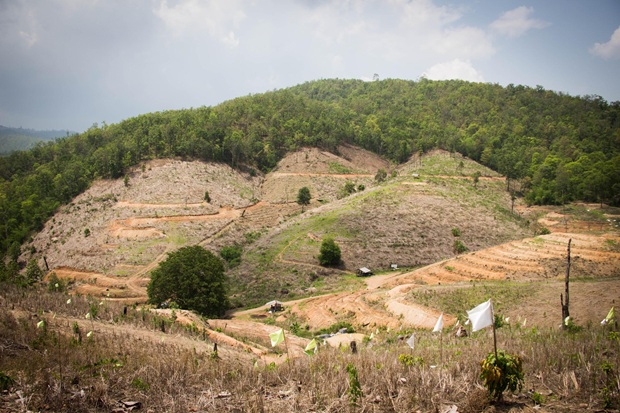Multi-stakeholder engagement for natural resources management: lessons from landscape restoration in Mae Chaem, Thailand shows that collaboration is key

Forest landscape restoration (FLR) offers a way to restore both degraded forests as well as the surrounding degraded landscape whilst offering socio-economic benefits to people in the wider area. The Mae Chaem model in Thailand is one real-life success story that shows that FLR can contribute to solving multiple problems in the landscape, and that multi-stakeholder collaboration is the key to success.

The Mae Chaem model of FLR intended to address declining agricultural productivity, environmental pollution, and deforestation. Local and higher level government agencies, civil society organizations, academic and research institutions and private sector actors all worked together with local communities to understand the problems they are faced with and to identify and implement solutions. This multi-stakeholder approach of finding a shared understanding of the problems and implementing joint interventions has already provided a number of benefits to the Mae Chaem landscape, and beyond, in just two years.
The Mae Chaem model has offered multiple livelihood benefits for the debt-laden local community, who have suffered financial losses in their previous production systems. For example, 42 families in one community had debt of 18 million baht in total. In identifying the root problem, the Mae Chaem model provided the local community with financial flexibility by freezing and refinancing loans through partnerships with local and national financial institutions, for example Bank of Agriculture and Agricultural Cooperatives. Additionally, the model has facilitated an increase in incomes by helping local communities to gradually switch from unsustainable corn monocropping -- which was reported to be in sharp decline in recent years due to the use of pesticides, soil erosion , and insufficient soil moisture to more sustainable options such as agroforestry and upland rice farming. Furthermore, the organic rice now being produced can be consumed by local communities as well as sold at a premium in markets, unlike the corn which was used for cattle feed. With support from the private sector, local communities have been linked to markets for selling organic products , consequently minimizing the need for agricultural land for subsistence and allocating more land for forest restoration.

In addition to strengthening food security and enhancing the livelihood of local communities, the Mae Chaem model offers environmental and social benefits. For instance, it forbids pesticide use and avoids the use of fire on agricultural land. While it may take years to see health benefits from reducing pesticide use, the cessation in the use of fire on agricultural land has already relieved tensions between local people and inhabitants of neighboring Chiang Mai -- the source of this tension was haze and polluted air from burning off. Haze and air pollution have been successfully minimized through initiatives such as a policy of zero burning for 60 days during a period when the air flows from the Mae Chaem towards Chiang Mai.
Consequently, by making progress towards addressing one another's land use and related concerns, trust among the stakeholders involved in the Mae Chaem model has been strengthened. They have together divided land into three different categories and have developed strategies and plan to restore forests considering local communities’ need and degradation status of lands. As part of that, in the first year they constructed terraces, build trench to retain water and planted multipurpose plant species on selected area they identified as degraded (shown on photo below). This increased trust has boosted confidence to scale up collaboration for the greater cause of restoring forested landscapes and improving local livelihoods through locally negotiated processes.
The Mae Chaem model, which is the first of its kind in Thailand, also pointed to issues and gaps that need to be addressed for scaling up and providing sustainable outcomes. Although central and provincial stakeholders were found to be supportive of the development and implementation of the model, stakeholders reported the need for more connected and flexible central government policy and harmonized working procedures among government agencies. Such flexibility and harmonization is needed to facilitate integrated planning and development, and for implementing tenure related agreements among stakeholders at the local level. Financial, technical and information resources need to be significantly increased given the large amount of ground work the stakeholders need to undertake and the capacity development required to move forward.
While it may take years to see whether, and to what extent, the Mae Chaem model of FLR will restore the degraded forest and its surrounding landscapes, the multi-stakeholder engagement that emerged in the process is encouraging. It emphasizes the necessity for local communities to have clear and secure rights to manage natural resources, as involving them in natural resource management decision-making contributes to ensuring their livelihoods are not endangered. Additionally, there is a need to create environments for local government authorities and other stakeholders to engage at the local level through supportive policy, laws and procedures. These aspects of the model are instrumental in encouraging local communities to move towards a more sustainable path of restoring the forested landscape and working with other stakeholders in managing the landscape.
Read more:
Forest landscape restoration for Asia-Pacific forests
https://www.recoftc.org/reports/forest-landscape-restoration-asia-pacific-forests

